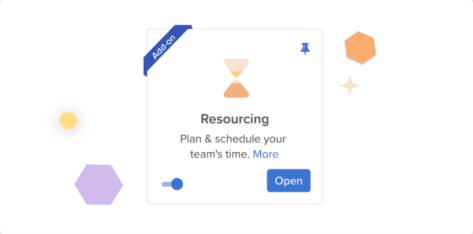It’s hard enough to manage your own workload, let alone the work capacity of each person across your entire team. That’s why Hive has built a comprehensive Resourcing app right inside its productivity platform — because what’s more productive than properly managing your team’s workload? Whether you’re on a marketing team or another team in your company, you’re sure to find Resourcing helpful.
If you’ve landed on this article, chances are that you’re already aware of how Resourcing can help your team. But if you’re not familiar with Resourcing, or if you just want further insight, let’s look at some of the business goals it can help you achieve. Do any of the following goals sound familiar to you?
- You want to gain visibility into the clients & tasks that are taking most of your team’s time
- Ensure you are aligning your estimated time with how the team is actually spending time
- Find the most labor-intensive work in your team, and try to optimize this
- Document for clients the time you spend above and beyond working on their projects
If so, you’re in the right place. We’re going to walk through how to configure Hive’s Resourcing module, so you can start uncovering these insights and drive some change in your organization!
Note: It’s preferable that you’re starting with your projects already created & entered in Hive, so check out one of our other Workflow guides if you haven’t completed that step yet!
Step 1: Turn on Resourcing in Hive Apps
Head to Apps on the left-hand panel and toggle on Resourcing:
Step 2: Pick your Resourcing “Zoom Level” ????
Where do you currently estimate effort for your team’s work? Pick which is closest to what your team does.
a) At the task-level
This means you estimate how long each step in your plan will take, which ultimately allows you to be granular. In this case, we recommend that Time-tracking is also toggled on in Hive Apps so that you can enter estimates onto action cards within your plans.
To reiterate, task-based estimates are added per person, per action card
- Estimates are usually more granular and are always attached to specific actionable to-dos. Remember actions are things that people can “do” & check off their list
- The estimates will follow the project plan, so shifts in the project plan automatically update your Resourcing view
- Estimates appear as guidance for individuals about their allocated time, when they look at My Actions view.
Go to each action card where you want to enter time, and use the Estimates section to add the time. Remember to add the due date to the card, so it will be visible within Resourcing.
b) At the Project-level
This means you will be using resource assignments, and estimates will be added per person, at the project level. This is typically used as broader “buckets” of time for blocking out people’s availability in assignments when the exact tasks are not known or the level of granularity is too much to maintain for the team.
Keep in mind that Resource assignments do not appear in My Actions View, as they are not things to be completed. They also do not move with project plan updates. To add an assignment, go to the Resourcing View and double-click onto the individual’s line where you want to add the estimate. From there:
- Add the project
- Adjust the effort
- Add the dates
- Remember to confirm! (This sends the user a notification)
Step 3: Do you resource by team?
Do you manage people on assigned teams, and you would like to see the workload of the entire team? For example, viewing how much capacity for work the Design Team has at any given time.
If Yes: Create teams and set employees as team members in Resourcing. You can do this via the Settings icon (looks like a gear) in the top right hand corner of Resourcing.
Step 4: Does your team have specific roles or special skills?
If you answered yes, great! In the same setting view as above in Step 2, you will want to also add Roles & User tags Assign each person a role, or User Tag after they are created.
If your team members don’t have specific roles, and breaking down by “Team” is granular enough for you, no further action is needed. You’re all set to get started!
Step 5: Notify your team and get to work
We think it’s best to call a Team Meeting with anyone involved or impacted by the Resourcing workflow. And if you want more advice, you can always use our guide for Running Great Meetings in Hive.
Before you relay the news to the rest of your team though, make sure you agree on the motions of resourcing for your team. Consider the following:
- Will you add Estimates & using Placeholders in your Project Templates so you don’t need to reinvent the wheel when a new project kicks-off?
- How will you deal with overallocation (will people work more hours, or will timelines shift, or will more headcount be required)?
- Can everyone see Resourcing, or do you need to restrict visibility for any reason? Review that setting here.
Once your team is aware of the new process, it’s time to get to work. Using the Resourcing app, should be able to manage your team’s workload more effectively, in an easy-to-understand view that matches your team structure. We know staffing your team appropriately is both an art and a science — and Hive is here as the platform to host these great masterpieces!
